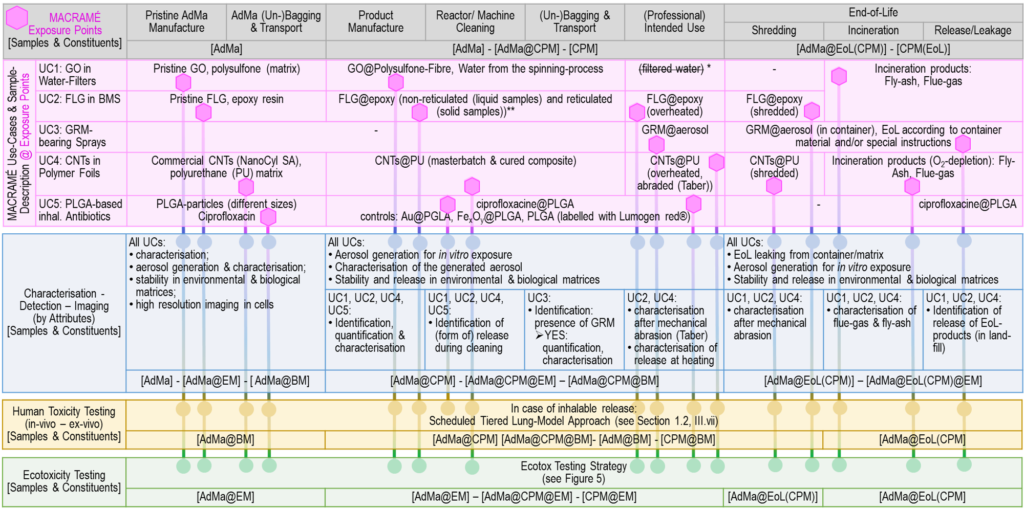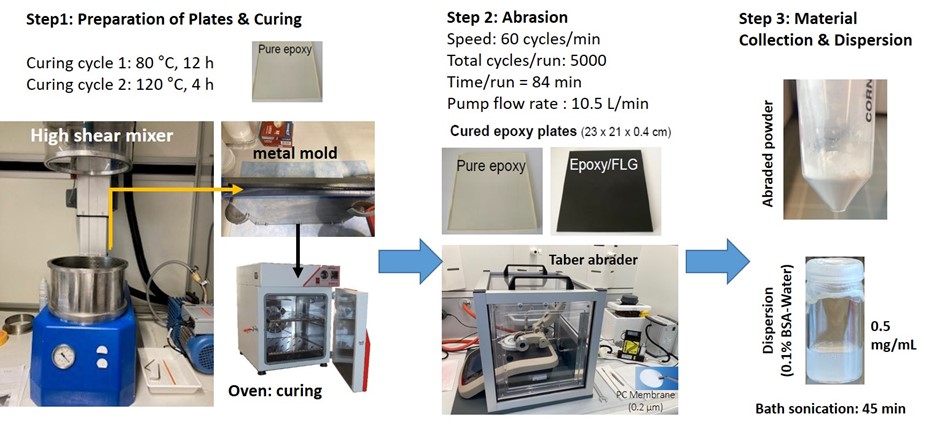To support development, harmonisation, and benchmarking of testing methods applied within the HorizonEurope-funded Project, a MACRAMÉ Control Material Library (CML) has been established. The Library contains representative materials with largely known properties impacting the in vitro test development and of materials to be investigated in the MACRAMÉ Use Cases (UCs). Over the remaining Project duration, data gaps will be filled, and measurement protocols will be developed to identify and describe critical attributes impacting the toxicological profiles of CML materials, which fall into three main categories:
- Materials of known properties to develop, harmonise and validate the generation of aerosols and the development of toxicological in vitro models;
- Advanced Materials (AdMas) in their pristine status (e.g. Few Layer Graphene-FLG, Graphene Oxide-GO, Carbon Nanotubes-CNTs, poly(lactic-co-glycolic acid)-PLGA nanoparticles and Polycaprolactone-PCL nanoparticles), representing materials and products investigated in MACRAMÉ’s use cases; and
- Materials to study the properties of UC products at their “end of life”, i.e. after controlled abrasion or incineration.
The aim of setting up a specially tailored CML is many-fold; the selected materials shall be used for the development, harmonisation and standardisation of the methods included in all MACRAMÉ’s R&I activities. Besides the controlled aerosol generation and the harmonisation of the tiered in-vitro model approach for a toxicological risk assessment, materials for establishing high-resolution imaging methods were to be included, allowing a quantification and characterisation of nanomaterials and AdMas in complex matrices. Eventually, a well selected sub-group of CML materials shall be made available for the scientific community to support studies on safety and characterisation of AdMas beyond the duration of the MACRAMÉ Project.
MACRAMÉ Material Families & market-relevant Use-Cases
The Project concentrates on advancing and developing methodologies that are applicable to nanomaterials, and widens them to ‘Advanced Materials’ (AdMas) ⎼ a material category that includes but surpasses that of ‘nanomaterials’ (EU, ‘Definition of a Nanomaterial’) – in commercialised products and that are aligned with the future-oriented innovation, safety and sustainability considerations of the OECD (OECD (2020)), the EU (EU (2022)), and several of its Member States (e.g. Germany (2021)). This will be achieved through development and demonstration of novel methodologies, and by advancing their harmonisation & standardisation on three MACRAMÉ Material Families of inhalable carbon-based AdMas of various morphologies and dimensions (Tiwari et al. (2012)), beyond spherical particles: (a) graphene-related material (GRM), (b) carbon nanofibres (CNFs), e.g., carbon nanotubes (CNTs), and (c) Poly Lactic-co-Glycolic Acid (nano)particles (PLGA).
The Project team identified the relevant MACRAMÉ Exposure Points, at which exposure of humans and/or the environment to advanced materials may occur, based on the product-relevant value-chain considerations of five market-relevant MACRAMÉ Use-Cases, chosen to be representative of the three carbon-based MACRAMÉ Material Families (i.e. (a) GRM (incl. GO (graphene oxide) and FLG (few-layer graphene)), (b) carbon fibres (i.e. CNTs), and PLGA). The resulting detailed MACRAMÉ R&I Strategy (M02) refines the product-relevant exposure points, control materials, sampling strategy, operating procedures for sampling, sample-size (i.e. quantity of a sample) and -provision arrangements, specific R&I activities to be conducted for each sample (i.e. exact characterisation and (quantitative) imaging and detection methods) and instrument-exchange. Part of this strategy is the ‘Sampling and Sample-Provision (to WP2 Partners) Procedures of representative inhalable Materials from the five Use-Cases established’ (Milestone M4.1, to implemented and completed in WP4). The Exporsure Points of each of the five market-relevant MACRAMÉ Use-Cases are illustrated in Figure 1:
- Use-Case 1 (UC1) – Graphene oxide (GO) flakes in drinking-water filters
- Use-Case 2 (UC2) – Few-layer graphene (FLG) in battery management systems (BMS)
- Use-Case 3 (UC3) – GRM-bearing sprays
- Use-Case 4 (UC4) – Carbon nanotubes (CNTs) in Polymer Foils for thermal Applications (e.g. heated Car Seats)
- Use-Case 5 (UC5) – PLGA-based inhalable Antibiotics

The MACRAMÉ Exposure- Points have been used to define the samples that need to be taken from the industrial Use-Case processes by the relevant providers and sent to the characterisation- and testing partners, adhering to the ‘Sampling & Sample-Provision Protocols for AdMas in complex Matrices’, agreed by all participating partners. The combinations of advanced materials (AdMas) in complex matrices (CM) to be studied in MACRAMÉ include all life-cycle-relevant occurrences of both (a) complex product matrices (AdMa@CPM), (b) degraded complex product matrices at the product’s end-of-life (EoL)(AdMa@EoL(CPM)), (c) regulatory relevant biological matrices for human toxicity testing (AdMa@BM), (d) environmental matrices for ecotox testing (AdMa@EM), and relevant forms of the different complex matrices, such as soot and char, and aerosols generated from compounding, machining, use, weathering, degradation or incineration of products.
A protocol for the abrasion of pure Epoxy and Epoxy-FLG materials has been developed and implemented, and the initial characterisation of abraded particles has already been conducted.

The CML will be made available as a new service to collaborating and future projects, extending repositories (e.g. the JRC’s repositories of certified reference materials or representative nanomaterials), by adding well characterised AdMas and AdMa@CMs (in complex matrices).
Follow this link to read the full report on the MACRAMÉ Control Material Library.






